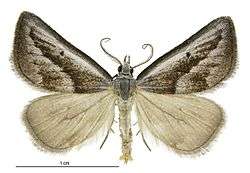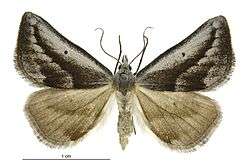Adeixis griseata
Adeixis griseata is a species of moth of the family Geometridae. It is endemic to New Zealand.[2]
| Adeixis griseata | |
|---|---|
 | |
| Male specimen | |
 | |
| Female specimen | |
| Scientific classification | |
| Kingdom: | |
| Phylum: | |
| Class: | |
| Order: | |
| Family: | |
| Genus: | |
| Species: | A. griseata |
| Binomial name | |
| Adeixis griseata | |
| Synonyms[1] | |
| |
Taxonomy
This species was first described by George Vernon Hudson in 1903 from a specimen collected by Alfred Philpott at Seaward Moss in Southland.[3] There was some debate between taxonomists as to whether this species was distinct from the Australian species Adeixis inostentata. However in 1920, after comparing specimens of both species, Philpott concluded it was distinct enough to be regarded as its own species.[4][2]
Description
Hudson regarded this species as being extremely variable in the intensity of its markings and the depth of its colouring. The forewings of A. griseata are silver grey in colour with a small disk-shaped dot as well as with dark brown or blackish triangular shaped shading from the middle of the base of the forewing to its apex and a much smaller brown triangular shaped shading below this. The hind-wings are grey coloured tinged with yellow brown.[5]
Range
Specimens have been collected not only at Seaward Downs but also in other locations in the South Island such as Lake Manapouri,[4][6] as well as localities in the North Island such as in Whangarei,[7] Waimarino, Raetihi, Ohakuni and Kaitoki.[5] A. griseata has also been found on the Chatham Islands.[5]
Habitat
A. griseata tends to inhabit poorly drained or swampy areas with sedges, rushes, Gleichenia, and native shrubs such as Pittosporum and Coprosma.[8] However at present the host plant species of A. griseata is unknown.[9]
References
- "Adeixis griseata (Hudson, 1903)". www.nzor.org.nz. Landcare Research New Zealand Ltd. Retrieved 1 February 2017.
- Dugdale, J. S. (1988). "Lepidoptera - annotated catalogue, and keys to family-group taxa" (PDF). Fauna of New Zealand. 14: 191. ISSN 0111-5383. Retrieved 1 February 2017.
- Hudson, George Vernon (1903). "On Some New Species of Macro-lepidoptera". Transactions and Proceedings of the New Zealand Institute. 35: 244–245 – via Biodiversity Heritage Library.
- Philpott, Alfred (1920). "Notes and descriptions of New Zealand Lepidoptera". Transactions and Proceedings of the New Zealand Institute. 53: 337–342 – via Biodiversity Heritage Library.
- Hudson, George Vernon (1928). The butterflies and moths of New Zealand. Wellington, N.Z.: Ferguson & Osborn Ltd. pp. 133–134. Retrieved 1 February 2017.
- Clarke, Charles E. (1934). "The Lepidoptera of the Te Anau-Manapouri Lakes Districts". Transactions and Proceedings of the New Zealand Institute. 63: 112–132. Retrieved 1 February 2017.
- Patterson, S. C. (1930). "List of Lepidoptera of Whangarei". Transactions and Proceedings of the New Zealand Institute. 61: 554–561 – via National Library of New Zealand.
- Holloway, J. D. (1979). A Survey of the Lepidoptera, Biogeography and Ecology of New Caledonia. Springer Science & Business Media. p. 260. ISBN 9789400995970. Retrieved 1 February 2017.
- "Notes on families and subfamilies of larger moths included in this Guide | Larger moths of New Zealand | Landcare Research". www.landcareresearch.co.nz. Landcare Research New Zealand Ltd. Archived from the original on 19 April 2017. Retrieved 1 February 2017.